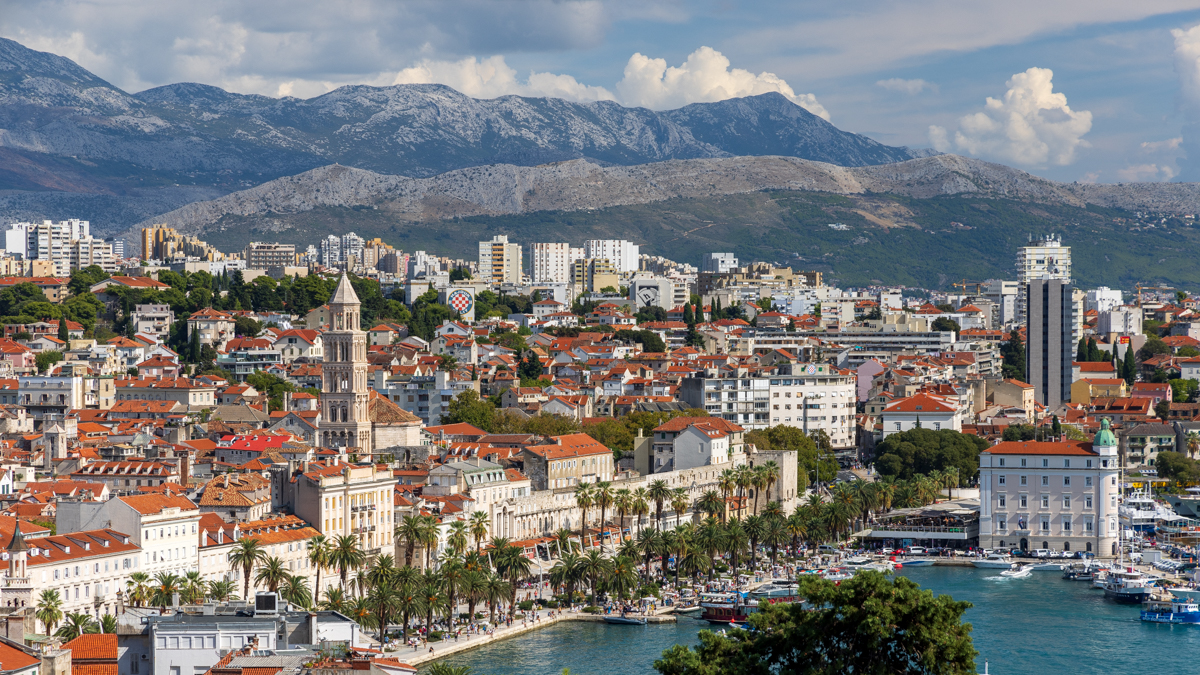
ANCIENT CITIES OF CENTRAL DALMATIA
There’s a black sphinx in the city of Split
from Diocletian’s time. Her granite face
has watched the world turn for more than three millennia
(her eleven siblings were all beheaded),
her Egyptian cradle now a thing of the past. Oliver Tearle
SPLIT
Split’s history spans over 2,300 years, evolving from an ancient Greek settlement to a modern Croatian city. It started as a Greek colony in 3d century BC. Split is most famous for Diocletian’s Palace, a UNESCO World Heritage Site and one of the world’s best-preserved Roman structures. Built in the 4th century by Roman Emperor Diocletian as his retirement residence, this massive complex now forms the heart of Split’s old town.
Diocletian was born in Dalmatia and rose from humble origins to become one of the most influential emperors in Roman history. He was able to end the Roman Empire crisis of the Third Century which was a period of political instability and near anarchy by establishing a new system of government called Tetrarchy, or “rule of four,” dividing power among four co-emperors. He implemented significant reforms that laid the foundation for the Byzantine Empire. He is also famous for his persecution of Christians.
Unlike most other Emperors he voluntarily abdicated in 305 CE and retired to his palace in Split. When asked to return to power, Diocletian famously refused, stating, “If you could show the cabbage I planted with my own hands to your emperor, he definitely wouldn’t dare suggest I replace the peace and happiness of this place with the storms of a never-satisfied greed.”

You usually enter the Palace through the Golden Gate. In front of that Gate stands a magnificent statue of Gregory of Nin by Ivan Meštrović (see above). He was a was a Croatian bishop in the Middle Ages who strongly opposed the Pope and introduced the use of national language in religious services.
Beautiful St Domnius Cathedral is also part of the Diocletian Palace complex. The story of St Domnius and Diocletian is full of turns and twists.
- Persecution: St. Domnius, the Bishop of Salona (the Roman capital of Dalmatia), was born in Antioch. During Emperor Diocletian’s persecution of Christians in 304 CE, he was martyred.
- Execution: A year prior to Diocletian’s retirement, St. Domnius and seven other Christians were executed in Salona.
- Retirement of Diocletian: Diocletian constructed a mausoleum for himself at his Split palace when he retired there in 305 CE.
- Historical Irony: Diocletian’s mausoleum was transformed into a Christian cathedral worshiping the Virgin Mary by the 7th century, complete with altars dedicated to St. Domnius and St. Anastasius.
- Final Revenge: When the mausoleum was remodeled, the sarcophagus containing Diocletian’s remains was ritually destroyed.
- Lasting Legacy: Today, the Cathedral of St. Domnius in Split, housed in Diocletian’s former mausoleum, is considered the oldest Catholic cathedral still in use in its original structure.
The images below depict the Palace as a live, breathing place where people still congregate, get married, dance, and dine. It is a feast for the senses, where history and modernity coexist.
https://www.nationalshrine.org/blog/basilica-artist-spotlight-ivan-mestrovic/
TROGIR
We visited another beautiful ancient city – Trogir on a day trip from Split. Trogir also boasts a remarkable 2300-year history of continuous urban tradition. It was founded by Greek colonists from the island of Vis in the 3rd century BC. Both cities were under Venetian rule for almost 400 years from 1420 till late 18th century which left an indelible mark on the city’s architecture. The Venetian influence in Trogir contributes significantly to its charm as a cultural crossroads, blending harmoniously with earlier Greek and Roman elements to create a stunning seaside setting. It is tiny, quiet and peaceful compared to the chaotic Split.
We also visited Zadar on the way from Split to Plitvice National Park.

ZADAR
We visited Zadar on the way from Split to Plitvice National Park. It would have been wonderful to spend more time in this beautiful town, visit its beaches and see Kornati National Marine Park. It consists of 89 islands, islets, and reefs, offering visitors a stunning marine experience
